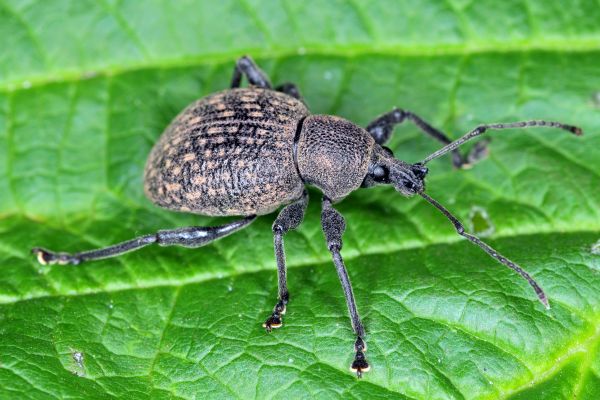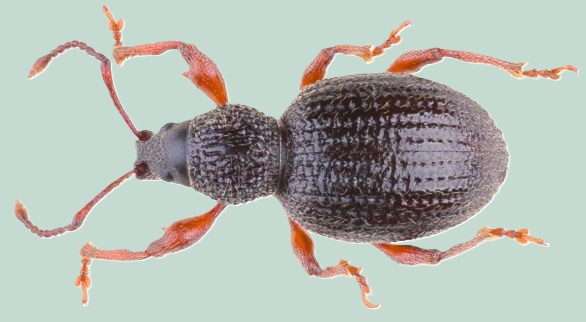
A concerned homeowner walked into my office carrying a small beetle she had found in her home, which is known to cause unhealthy plants. She had been seeing so many of them lately. The culprit? A home-invading weevil, likely the strawberry root weevil (Otiorhynchus ovatus), one of the most common weevils found inside homes in our region.
Weevils are small beetles characterized by their distinct snouts and pear-shaped bodies. The larvae, which are legless and grub-like, feed on plant roots, while the adult weevils seek shelter indoors, particularly during hot and dry weather. These pests typically enter buildings through cracks in foundations, doors, and windows. Although they may seem alarming, they do not harm people, pets, or property and don’t cause significant damage to plants that would be found around homes, but are merely a nuisance, and often only a temporary nuisance. However, nurseries and commercial growers may encounter economically significant damage under certain conditions.
Identifying the strawberry root weevil
 Strawberry root weevils are small, dark-colored beetles with distinctive snouts. Their bodies are pear-shaped, measuring about 1/4 inch long, with black or dark brown coloration and rows of pits along their backs. Unlike some other beetles, strawberry root weevils cannot fly.
Strawberry root weevils are small, dark-colored beetles with distinctive snouts. Their bodies are pear-shaped, measuring about 1/4 inch long, with black or dark brown coloration and rows of pits along their backs. Unlike some other beetles, strawberry root weevils cannot fly.
These weevils are often mistaken for ticks due to their dark, compact bodies, but they can be distinguished by their six legs (ticks have eight). Also, note that larval ticks have six legs and later gain a pair when molting to the nymphal stage. However, larval ticks are considerably smaller and are unlikely to be mistaken for these weevils.
Weevils are attracted to moisture and are frequently found in sinks, bathtubs, water basins, and other moist places. Strawberry root weevil larvae feed on the roots of various plants, including strawberries, evergreens (such as arborvitae and spruce), raspberries, grapes, and other landscape plants. Adults normally emerge in early summer and feed on the edges of leaves.
Keeping weevils out of your home
- Seal cracks and openings around foundations, windows, and doors with caulk.
- Ensure screens and doors fit snugly.
- Reduce excess moisture around the home’s foundation.
- Remove plant debris and mulch near the house where weevils may hide.
Managing weevils indoors
- Physical Removal: The best way to deal with weevils indoors is to sweep or vacuum them up. Dispose of the vacuum bag promptly to prevent them from escaping.
- Pesticides: Chemical treatments are generally unnecessary, as weevils do not cause damage indoors and will eventually leave on their own. However, in cases of severe infestations, perimeter treatments with insecticides like permethrin or bifenthrin can be applied around the home’s foundation.
Controlling weevils in home landscaping
- To control adults, apply insecticide sprays containing permethrin, bifenthrin, cyfluthrin, or cyhalothrin to the lower trunks, branches, and bases of plants in the evening when weevils are active. Soil-active, persistent, systemic sprays that move to the roots and leaves have also proven effective when applied around the trunk of the plant. Avoid spraying flowers to protect pollinators.
- Use biological control with Heterorhabditis bacteriophora, a beneficial nematode, to target larvae in the soil. The best time for application is mid-July through mid-September when larvae are actively feeding.
Final thoughts and caution
The presence of home-invading weevils in large numbers this year does not necessarily indicate a recurring problem next year, as their populations naturally fluctuate from season to season. If you choose to use pesticides, always follow the label directions provided on the container. Ensure that the treatment area is specifically listed on the product label. Remember, the label is the law.
Reference
- Cranshaw, W. S. &. (2019). Fact Sheet No. 5.551 Insect Series. Colorado State University Extension.
- University of Minnesota Extension (2024) Home-invading weevils.


